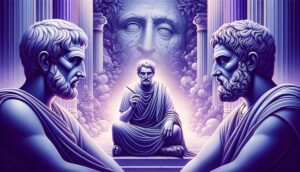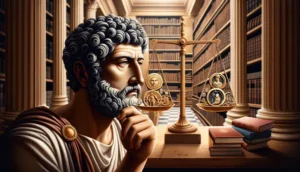Table of Contents
Probably the most asked question for anyone starting in Stoicism is “Where do I start?” The study of Stoicism can be divided into two broad categories: classic and modern. If you are interested in learning the philosophy on a deep level, you should start with the classics. However, if you wanted to have just enough grasp you can read modern commentaries. Learn me explain.
I. Classic Stoicism
Stoicism was founded by Zeno in the early 3rd century busy in Ancient Greece. The philosophy then spread and become dominant in Ancient Rome during the Roman Empire. Classic Stoicism refers to the works in Ancient Greece and Rome. However, none of the work in Ancient Greece survived. What we have now is the work from the Roman Stoic philosophers mostly from Marcus Aurelius, Seneca, and Epictetus
The following are the most important work of each of the classic Stoic philosophers:
- Meditations – Marcus Aurelius
Meditation is a personal diary of the Emperor of Marcus Aurelius. As far as Stoicism doctrine is concerned, it has the least information. The book is full of aphorism as each entry in the book are maxims (like quotes). Not to say it’s an inferior classic Stoic resource, in fact it’s the main influence behind how I write my own meditations journal as well as other modern practicing stoics who are into journaling to reflect their daily lives. The book will tell you how the late emperor who controlled all of the known worlds tried to live a virtuous life despite the massive temptation he has with his power.
There are a lot of translations out there but the one I found the easiest to understand is the work of Gregory Hays.
- Letters from a Stoic – Seneca
If you wanted to learn the bulk of the Stoic doctrine, this is the book you should explore. It contains 124 letters Seneca sent to his friend Lucilius giving him advice about life and incorporating a lot of the Stoic doctrine. The one thing I like about this classic work is its consoling nature. Seneca was already very old and extremely ill when he wrote the letters and you would really feel that the old man pour a lot of wisdom into them. It would take an average of 15 minutes to read each letter but you might have to re-read some of the letters to understand them. I like to read one letter every morning and its consoling nature helps me set up good for the days ahead.
There are a lot of books that compile the letters of Seneca but some of them have missing pieces. The one I found with letters complete is the book by Penguin Classics Letters from a Stoic. There is a little bit of challenge in some of the letters because of the old language Seneca used so we created a summary and key takeaways of each letter to help you with some of the most important concepts.
Epictetus was a former slave who gained his freedom because of his intellect. He then became a teacher and one of the most prominent Stoic philosophers. Being a teacher himself, I found Discourses to be a lot preachy. Reading his book would feel like seating in a classroom with a teacher that has a good sense of humor. He seemed to be a personal favorite of modern practicing stoics and popular philosophy professors such as Massimo Pigliucci.The best translation I could find is from Penguin Classics, Discourses and Selected Writings.
II. Modern Commentaries
The classic books on Stoicism can at times a little bit of a challenge because of the old language (Latin) that was used to write them. A relatively easier to understand are those books written about Stoicism in 21st Century. The majority of these books are self-help books that are designed to address problems that still exist in the modern world such as anxiety, overcoming obstacles, dealing with negative perceptions, and fear of death. etc. One important thing to note is that they are not necessary the old Stoicism doctrine but are interpretations designed to solve modern human issues.
The following are some of the most popular modern books on Stoicism:
1. A Guide to the Good Life by William B. Irvine
A Guide to the Good Life by William B. Irvine is probably the best modern book on Stoicism. The book is filled with psychological techniques that are deeply rooted in the ancient philosophy of Stoicism such as negative visualization, the dichotomy of control, self-denial, and meditation. It also gives advice from the stoic perspective about anger, grief, personal values and the fear death. If I have to pick one book that discusses Stoicism from a more practical approach, I would definitely choose this book.
2. The Obstacle is the Way by Ryan Holiday
The book Obstacle is the Way by Ryan Holiday introduced me to Stoicism. Holiday highlights three steps in overcoming any obstacle: changing perception about the challenge, how to take action, and the discipline of the will.
- A Handbook for New Stoics by Massimo Pigliucci and Gregory Lopez
This is a book that contains 52 week by week lessons designed to incorporate some of the most popular stoic techniques. If you really wanted to incorporate Stoicism into your life, this is a great book to dive into. It was designed so that you can focus on one lesson a week and then complete all lessons in 1 year (52 weeks).
These are the books that I personally read. Some of the most popular books that are frequently mentioned in social media groups and online forums are as follows:
- The Daily Stoic by Ryan Holiday
The Daily Stoic by Ryan Holiday offers a year-long journey into Stoic philosophy, distilling timeless wisdom from Stoic thinkers like Marcus Aurelius, Seneca, and Epictetus into daily meditations. Each day presents a thought-provoking passage accompanied by Holiday’s insightful reflections, guiding readers to apply Stoic principles to modern challenges. This daily practice encourages mindfulness, resilience, and virtue, making Stoicism accessible and relevant for personal growth and philosophical exploration in everyday life.
5. How to Think Like a Roman Emperor by Donald Robertson
6. Ego is the Enemy by Ryan Holiday
7. Stillness is the Key by Ryan Holiday




